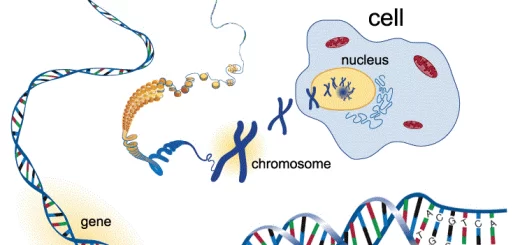Histology, Molecular structure of the cell membrane, Cell function and structure
Histology is a medical basic science dealing with the microscopic anatomy of cells, tissues, and organs, in order to correlate their structure with their function. The study of histology is dependent upon several tools, mainly the use of different types of microscopes to examine tissues and microtechniques which means the preparation of tissues to make them suitable for microscopic examination.
The Cell
The cell is the smallest structural and functional unit capable of independent existence in all living organisms. The human body is composed of more than 200 different types of cells, however, all cells have a common basic structure.
Generally, the cell is formed of 2 major components: the nucleus and the cytoplasm. The cytoplasm is a dense fluid matrix, the cytosol and it contains the cell organelles and the cell inclusions. Each cell is bounded by the cell membrane, separating the cytoplasm from its extracellular environment.
A cell membrane (Plasma membrane, Plasmalemma)
It is a vital dynamic membrane that surrounds the cell. The presence of an intact cell membrane is essential to cell survival.
LM picture
At low magnification, the plasma membrane appears as a thin dense line 8-10 nm in thickness. With higher magnification, this line appears as a trilaminar structure, with an outer (= extracellular leaflet) and an inner (=cytoplasmic leaflet) electron-dense lines and a middle electron-lucent zone in between. The entire structure is known as the unit membrane.
Molecular structure of the cell membrane
The cell membrane and almost all the membranes surrounding the membranous organelles have the same structure except for minor differences. These biological membranes consist mainly of the bimolecular layer of phospholipids in which specialized proteins are suspended in association with surface carbohydrates. Membrane phospholipids and the associated proteins are usually present in a 1:1 proportion by weight.
Lipid molecules of the cell membrane
Phospholipids: each phospholipid molecule consists of One polar hydrophilic head that faces the aqueous media on either side of the membrane (the tissue fluid at the outer surface of the membrane or the cytosol at the inner surface of the membrane). Two long non-polar hydrophobic fatty acids tails project towards the center of the membrane facing each other. They form weak non-covalent bonds with each other, holding the bilayer together.
The phospholipid molecules are responsible for the semi-permeability of the cell membrane. They prevent the passage of water-soluble substances and ions, however, they allow passage of small non-polar and fat-soluble substances.
Cholesterol: They are incorporated within the lipid bilayer. Membrane cholesterol molecules are responsible for the stability of the membrane components and regulation of membrane fluidity in body temperature.
Protein molecule of the cell membrane
They are present in two forms: Integral membrane proteins and Peripheral membrane proteins. Integral membrane proteins are embedded within the lipid bilayer. Most of these proteins traverse the whole thickness of the membrane and are called transmembrane proteins. There are six functional forms of integral membrane proteins:
- Pumps serve to transport ions (Na+, K+) activity across the membrane.
- Channels serve to transport certain substances passively across the membrane.
- Receptors allow binding and recognition of specific substances (ligands) e.g. hormone on the extracellular surface of the membrane.
- Enzymes possess various enzymatic activities, for example, ATP synthase of the inner mitochondrial membrane and some types of digestive enzymes in the small intestine.
- Linkers serve to anchor the intracellular cytoskeleton to the extracellular matrix.
- Structural proteins form junctions between neighboring cells.
Peripheral membrane proteins
They are not embedded into the lipid bilayer but they are loosely associated with the membrane surface. They are usually located on the cytoplasmic surface of the membrane. They form a link between the cell membrane and the cytoplasmic components.
Carbohydrate molecules
The carbohydrate residues are present as glycoproteins and glycolipids of the cell membrane. They are always oriented towards the outside of the membrane with their branching saccharides extend some distance beyond the cell surface forming the cell coat or glycocalyx.
The glycocalyx of the plasma membrane varies from species to species and even from one cell type to another. The diversity of the molecules and their location on the cell’s surface enable membrane carbohydrates to function as markers that distinguish one cell from another.
The cell is responsible for
- Cellular recognition e.g. the glycocalyx on the surface of red blood cells (RBCs) determines the four human blood groups.
- Cell-to-cell adhesion.
- Formation of receptor sites for ligands by the glycoproteins of the cell membrane.
The trilaminar structure of the cell membrane seen in EM after fixation with osmium tetroxide is caused by the deposition of osmium on the hydrophilic heads of the phospholipid molecules resulting in two electron-dense lines, while the hydrophobic tails of the lipid molecules remain unstained resulting in the intervening pale zone. The cell coat is represented by the fuzzy material on the outer surface of the membrane.
Types of Transport through cell membranes, Active transport, Simple & Facilitated diffusion
Types of Transport through cell membranes, Active transport, Simple & Facilitated diffusion
Vesicular transport of Macromolecules across the cell membrane, Endocytosis & Exocytosis
Parts of cell & How can the cell perform its functions?
Non-membranous organelles and membranous organelles in the cytoplasm
Diversity of cells, Cell theory, Role of scientists in discovering cell & its structure
Parts of cell & How can the cell perform its functions?



